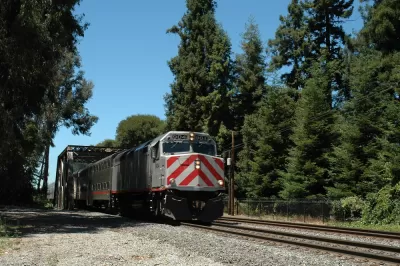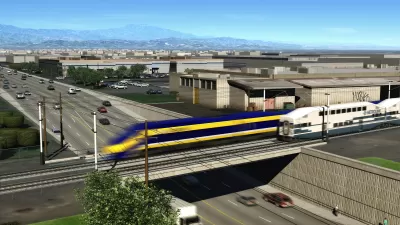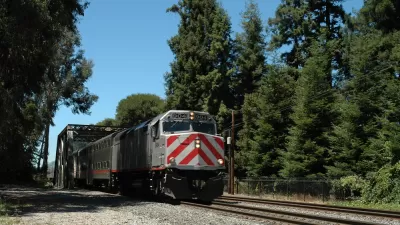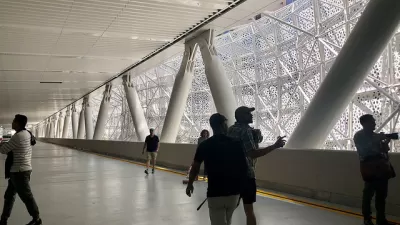Transit adjacent developments have their downsides when the transit is a diesel-powered commuter train, and the location is a stub-end terminal. Case in point: San Francisco's Mission Bay.

The San Francisco-to-San Jose railroad is a lifeline for San Francisco residents who work on the Peninsula and Silicon Valley, and for suburban residents who work in "the City" who don't want to drive Hwy 101 and pay for expensive downtown parking. But the train's open-air terminal is not downtown; it's adjacent to the fast-growing Mission Bay neighborhood.
"At the San Francisco station, which has 12 tracks, the first trains start rolling around 4:10 a.m. every weekday, and the last one pulls in at 12:05 a.m.," reports Rachel Swan for the San Francisco Chronicle on Nov 26. "During the slower-paced weekend schedule, trains run from 8 a.m. until midnight."
“It wouldn’t be so bad if we were dealing with a less-dangerous chemical, but diesel is poison,” said [Mission Bay resident Jerry] Levine, who for years has led a neighborhood campaign to get Caltrain to minimize the emissions from its locomotives while neighbors wait for the rail system to go electric in 2022. [See photo of idling Caltrain locomotive at San Francisco terminal, with Mission Bay highrises in background].
An astute observer would note that the Caltrain depot's neighbor's should have known what to expect. Caltrain began service in an earlier form in 1863, with the present San Francisco terminal on Fourth Street between Townsend and King Streets opening in 1975. Mission Bay, a former salt marsh and lagoon, was transformed partly into railyards and has undergone redevelopment into San Francisco's newest neighborhood beginning in 1998.
"Since 2000, developers have quilted the once-deserted terrain with 24 residential buildings and nearly 5,500 residential units," writes Swan.
The good news is that Caltrain electrification broke ground in July, is fully-funded, with 16 double-decker electric multiple-unit trains set to begin operation in 2022. The bad news: Caltrain will continue to operate diesel train as the new EMUs will only handle 75 percent of the schedule due to budgetary constraints for the first phase of electrification, according to Green Caltrain.
So for the next five years, Mission Bay residents will have to to rely on Caltrain and it's operator, TransitAmerica Services, to reduce emissions because "there are no state or federal laws that regulate idling diesel locomotive engines," writes Swan.
Caltrain’s manager of rail operations, Ben Burns, said the agency developed a strict protocol in February, partly in response to complaints by neighbors. The 29 passenger trains all have technology installed to turn off their engines automatically for layovers of more than 20 minutes, provided that the outside temperature, battery voltage and engine pressure are at levels that allow the trains to restart. Engineers are also required to shut trains down and hook them up to electricity if a layover is expected to exceed one hour.
In addition to electrifying the trains, another plan would demolish not only the train depot and all its tracks, putting the train in a tunnel, but also the adjacent Interstate 280 freeway, allowing for new development, reported The Chronicle's Matier & Ross in May 2015. A new Caltrain stop would be added opposite Pier 50 on Third Street to accommodate the new Warrior's arena as well as the AT&T Giants stadium. However, it's all contingent on extending Caltrain to the new Transbay Transit Center,
"[T]he city has been awarded $1.7 million in grants from the Metropolitan Transportation Commission and others to study the idea," note Matier & Ross.
FULL STORY: Some Mission Bay neighbors fuming over Caltrain’s diesel dust

Planetizen Federal Action Tracker
A weekly monitor of how Trump’s orders and actions are impacting planners and planning in America.

Congressman Proposes Bill to Rename DC Metro “Trump Train”
The Make Autorail Great Again Act would withhold federal funding to the system until the Washington Metropolitan Area Transit Authority (WMATA), rebrands as the Washington Metropolitan Authority for Greater Access (WMAGA).

The Simple Legislative Tool Transforming Vacant Downtowns
In California, Michigan and Georgia, an easy win is bringing dollars — and delight — back to city centers.

The States Losing Rural Delivery Rooms at an Alarming Pace
In some states, as few as 9% of rural hospitals still deliver babies. As a result, rising pre-term births, no adequate pre-term care and harrowing close calls are a growing reality.

The Small South Asian Republic Going all in on EVs
Thanks to one simple policy change less than five years ago, 65% of new cars in this Himalayan country are now electric.

DC Backpedals on Bike Lane Protection, Swaps Barriers for Paint
Citing aesthetic concerns, the city is removing the concrete barriers and flexposts that once separated Arizona Avenue cyclists from motor vehicles.
Urban Design for Planners 1: Software Tools
This six-course series explores essential urban design concepts using open source software and equips planners with the tools they need to participate fully in the urban design process.
Planning for Universal Design
Learn the tools for implementing Universal Design in planning regulations.
Smith Gee Studio
City of Charlotte
City of Camden Redevelopment Agency
City of Astoria
Transportation Research & Education Center (TREC) at Portland State University
US High Speed Rail Association
City of Camden Redevelopment Agency
Municipality of Princeton (NJ)





























